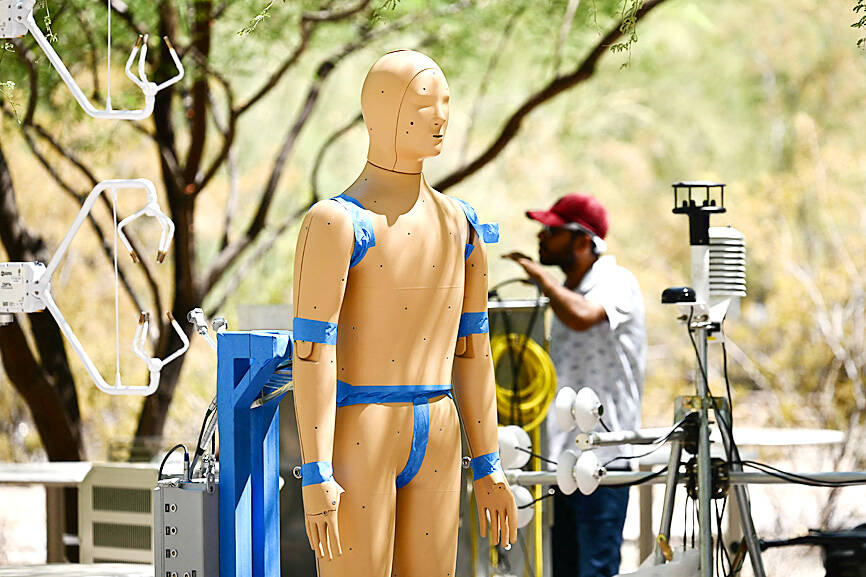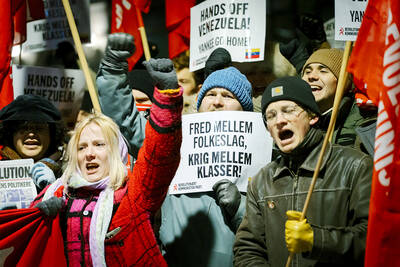What happens to the body when a human gets heatstroke? How can people protect themselves on a warming planet? To answer these burning questions, Arizona researchers have deployed a robot that can breathe, shiver and sweat.
The southwestern state’s capital, Phoenix, is enduring its longest heat wave in history: On Friday, the mercury exceeded 43°C for the 22nd day in a row, an ominous demonstration of what is to come in a world affected by climate change.
For humans, such heat represents a potentially lethal threat, one that is still not fully understood, but for ANDI — a one-of-a-kind humanoid robot at Arizona State University — it is a lovely day out.

Photo: AFP
“He’s the world’s first outdoor thermal mannequin that we can routinely take outside and ... measure how much heat he is receiving from the environment,” said Konrad Rykaczewski, associate professor at the university’s School for Engineering of Matter, Transport and Energy.
ANDI is “a very realistic way to experimentally measure how a human person responds to extreme climate” without putting people themselves at risk, Rykaczewski said.
At first glance, ANDI — which stands for Advanced Newton Dynamic Instrument — resembles a simple crash-test dummy, but its epoxy and carbon fiber skin conceals a treasure trove of technology, such as a network of connected sensors that assess heat diffused through the body.
ANDI also has an internal cooling system and pores enabling it to breathe and sweat.
There are 35 independent thermal zones and, like humans, the robot — which cost more than US$500,000 to build — sweats more from its back.
Until now, only a dozen or so mannequins of this type existed, and none of them could venture outdoors. They were mainly used by sports equipment manufacturers to test their technical clothing in thermal chambers.
Researchers hope the robot will provide a better understanding of hyperthermia — that is, when a body overheats, a condition that is threatening a growing proportion of the world’s population as a result of global warming.
For obvious ethical reasons, “nobody measures core temperature increase while somebody’s getting heatstroke,” Rykaczewski said.
Yet the effects of heat on the human body are still not fully comprehended, and ANDI gives researchers a chance to understand them.
Accompanied by MaRTy (Mean Radiant Temperature), a mobile weather station that measures the heat reflected by the buildings around it, the robot is taking its first steps outside in Phoenix — an ideal laboratory in which to prepare for tomorrow’s climate.
“How do we change what we wear? How do we change our behavioral patterns and adjust them to temperatures that are of this order of magnitude?” Rykaczewski said.
The ANDI robot is also infinitely reprogrammable.
The research team can make “digital twins of the mannequin to look at different segments of the population,” said Jennifer Vanos, a climatologist involved in the project.
For example, the older a person gets, the less they sweat, while young people need different protection from athletes or people in poor health. With ANDI, scientists can simulate the thermoregulatory mechanisms specific to each individual.
They can also test the robot in a variety of situations. For example, Phoenix is dry — what about humid heat? How does the human body cope in hot winds? Their research is likely to be useful for designing heat-resistant clothing, rethinking urban planning and protecting the most vulnerable.
In Phoenix, which opens dozens of cooling centers for the homeless every summer, their findings could guide the actions of social workers.
“How long should a person stay in a cooling center to cool off, so that their core temperature goes down to a level that’s safe again? We can answer that question with ANDI,” Vanos said.
The team also dreams of developing low-cost sensors to be used on building sites to adjust working hours according to the heat actually felt on site and the health of the workers — rather than based on general weather conditions.
That could be a “step towards better safety than just these blank recommendations per city, per state, per country,” Rykaczewski said.

Auschwitz survivor Eva Schloss, the stepsister of teenage diarist Anne Frank and a tireless educator about the horrors of the Holocaust, has died. She was 96. The Anne Frank Trust UK, of which Schloss was honorary president, said she died on Saturday in London, where she lived. Britain’s King Charles III said he was “privileged and proud” to have known Schloss, who cofounded the charitable trust to help young people challenge prejudice. “The horrors that she endured as a young woman are impossible to comprehend and yet she devoted the rest of her life to overcoming hatred and prejudice, promoting kindness, courage, understanding

‘DISRESPECTFUL’: Katie Miller, the wife of Trump’s most influential adviser, drew ire by posting an image of Greenland in the colors of the US flag, captioning it ‘SOON’ US President Donald Trump on Sunday doubled down on his claim that Greenland should become part of the US, despite calls by the Danish prime minister to stop “threatening” the territory. Washington’s military intervention in Venezuela has reignited fears for Greenland, which Trump has repeatedly said he wants to annex, given its strategic location in the arctic. While aboard Air Force One en route to Washington, Trump reiterated the goal. “We need Greenland from the standpoint of national security, and Denmark is not going to be able to do it,” he said in response to a reporter’s question. “We’ll worry about Greenland in

PERILOUS JOURNEY: Over just a matter of days last month, about 1,600 Afghans who were at risk of perishing due to the cold weather were rescued in the mountains Habibullah set off from his home in western Afghanistan determined to find work in Iran, only for the 15-year-old to freeze to death while walking across the mountainous frontier. “He was forced to go, to bring food for the family,” his mother, Mah Jan, said at her mud home in Ghunjan village. “We have no food to eat, we have no clothes to wear. The house in which I live has no electricity, no water. I have no proper window, nothing to burn for heating,” she added, clutching a photograph of her son. Habibullah was one of at least 18 migrants who died

Russia early yesterday bombarded Ukraine, killing two people in the Kyiv region, authorities said on the eve of a diplomatic summit in France. A nationwide siren was issued just after midnight, while Ukraine’s military said air defenses were operating in several places. In the capital, a private medical facility caught fire as a result of the Russian strikes, killing one person and wounding three others, the State Emergency Service of Kyiv said. It released images of rescuers removing people on stretchers from a gutted building. Another pre-dawn attack on the neighboring city of Fastiv killed one man in his 70s, Kyiv Governor Mykola